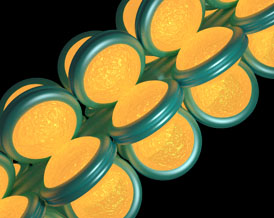 Often a diagnosis of thyroid cancer is associated with a good prognosis and fairly straightforward surgical treatments to remove the tumor followed by radioactive iodine ablation. Such treatment works well in tumors that have not metastasized and retain enough of their thyroid cell “identity” that they can still accumulate radioactive iodine.
Often a diagnosis of thyroid cancer is associated with a good prognosis and fairly straightforward surgical treatments to remove the tumor followed by radioactive iodine ablation. Such treatment works well in tumors that have not metastasized and retain enough of their thyroid cell “identity” that they can still accumulate radioactive iodine.
However, aggressive thyroid cancers, which often metastasize and recur, do not respond to standard treatments because they are generally too dedifferentiated to accumulate iodine, so alternative treatments are needed.
One approach is to look for compounds that will reverse dedifferentiation, making tumor cells more likely to take up and concentrate radioactive iodine regardless of their location in the body. One possible target to effect dedifferentiation is epigenetic modification of histone proteins.
Histone proteins are more than the structural components of the nucleosome that organizes the chromatin inside cells. Histone proteins are subject to a host of protein modifications on their N-terminal tails such as acetylation, phosphorylation, methylation, ubiquitination and ADP-ribosylation. These various modifications are seen as creating a “histone code” that is read by other proteins and protein complexes (1). This code regulates patterns of gene expression and activity for a cell—in part resulting in a differentiated phenotype. Previous studies have suggested that some histone deacetylase (HDAC) inhibitors (e.g., valproic acid) can reverse some of the dedifferentiation associated with aggressive cancers (2).
Jang, et al. in a recent paper (3) published in Cancer Gene Therapy synthesized a group of HDAC inhibitor analogs (AB1–AB13) and tested them for their ability to inhibit growth of three aggressive human thyroid cancer cell lines and induce partial re-differentiation to the thyroid cell phenotype.
After authenticating the identity of the cell lines they worked with, Jang et al. tested the ability of the analogs to inhibit cell growth of the cancer cell lines. Three of the analogs inhibited proliferation in a dose-dependent manner with an IC50 of <10µM in at least one of the three cell lines. They next set out to determine the mechanism of toxicity, and showed that treatment with each of the three inhibitors that inhibited cell growth also resulted in caspase-3 activation and PARP cleavage, indicating that apoptosis was induced in cells treated with these inhibitors.
The researchers next looked at the gene expression profiles of the cells treated with these inhibitors by measuring mRNA levels of thyroid-specific genes, including sodium iodide symporter (NIS; which is responsible for accumulation of iodine and the biological mechanism through which radioactive iodine ablation works for non-aggressive thyroid cancers). All three of the analogs significantly increased NIS mRNA expression in the three cell lines they investigated.
Finally, the researchers used a biochemical assay to investigate the specificity and activity of the analogs against both class 1 and class II HDAC isoforms. Of the three inhibitors, two were quite good HDAC inhibitors, with selectivity for HDACs 1, 2, and 3. The third analog was less potent class I/II inhibitor and showed essentially no selectivity.
Because there are no approved HDAC inhibitors to treat thyroid cancer, the authors of this paper conclude that the three synthetic HDAC inhibitor analogs characterized in this research study warrant further investigation. Not only did they demonstrate cytotoxicity, but they also induced expression of NIS, which could make aggressive cancer types more susceptible to radioactive iodine therapy.
Literature Cited
- Stahl, B.D. and Allis, C.D. The language of covalent histone modifications. Nature 403, 41–5.
- Gotticher, M. et al. (2001) Valproic acid defines a novel class of HDAC inhibitors inducing differentiation of transformed cells. EMBO J. 20, 6969–78.
- Jang, S. et al. (2015) Novel analogs targeting histone deacetylase suppress aggressive thyroid cancer cell growth and induce re-differentiation Cancer Gene Ther. 22, 410–6.
Michele Arduengo
Latest posts by Michele Arduengo (see all)
- An Unexpected Role for RNA Methylation in Mitosis Leads to New Understanding of Neurodevelopmental Disorders - March 27, 2025
- Unlocking the Secrets of ADP-Ribosylation with Arg-C Ultra Protease, a Key Enzyme for Studying Ester-Linked Protein Modifications - November 13, 2024
- Exploring the Respiratory Virus Landscape: Pre-Pandemic Data and Pandemic Preparedness - October 29, 2024
